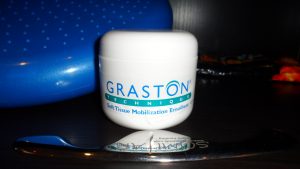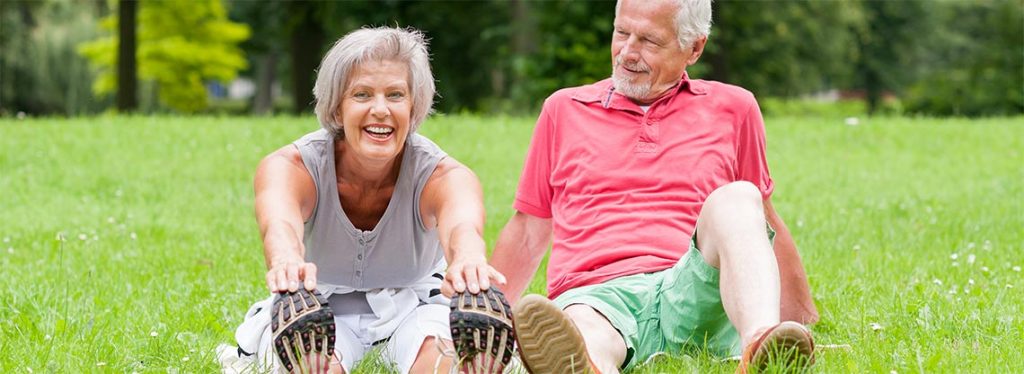Call today: 416-906-0767
Why “less is more” doesn’t work at first with chiropractic treatment
Have you ever had a terrible headache?
One of those bad headaches for a few hours where you feel drained and just want it to end already? What typically happens next is you lie down hoping it will end soon or you take a fast acting over the counter pain pill so you can enjoy your day. Shortly after, poof! The headache is gone and you feel a great sense of relief. You go to bed and wake up to be sadly surprised by yet another annoying headache. You start to wonder, was it the way I slept? Is it coming from my neck? It could be one of those, both or neither!
So what is the cause?
Commonly, there is postural strain going on like “text neck” or computer strain and the spinal joints/muscles get irritated. Having a chiropractic assessment will help to determine the root cause. That pain pill may have worked for short term relief, but it didn’t get to the root cause of your headache. Similarly, having a single chiropractic visit may provide great short-term relief, but a few treatments help to tackle the root cause of pain and will help decrease the frequency of reoccurring pain. The tension that’s in your neck and shoulders built up over time and takes time to decrease also. This is why having a few frequent treatments at first, often works better to decrease that pesky “muscle memory” and address the areas that need stretching/strengthening. Similarly, with migraines, some people have certain triggers like bright lights, chocolate, alcohol or stress. If stress management is done regularly (not just one yoga/meditative class, but a regular routine that works for you) it often produces better long-term results. Maybe it’s having regular “tune –up” treatments to offset joint pain and muscle tension, going to bed early or avoiding certain triggers like decreasing the brightness setting on your phone. I am here to help guide you on ways to decrease pain not just on a short-term basis, but on a long term basis with the use of self-directed stretches/exercises and chiropractic treatment plans that will help keep your spine aligned.
If you would like to arrange a chiropractic appointment, please email dr.mdavidovic@gmail.com or call 416-906-0767
Do you have mechanical neck pain?
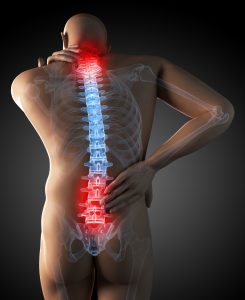 Neck pain has become increasingly common in that 2 out of 3 people will experience neck pain at some point. Mechanical neck pain and headache coming from the neck (cervicogenic headache) are quite common, so here is some info for you to help you further understand the relationship between spinal manipulation therapy (SMT) or the “adjustment” and decreasing neck pain.
Neck pain has become increasingly common in that 2 out of 3 people will experience neck pain at some point. Mechanical neck pain and headache coming from the neck (cervicogenic headache) are quite common, so here is some info for you to help you further understand the relationship between spinal manipulation therapy (SMT) or the “adjustment” and decreasing neck pain.
What does Mechanical neck pain mean?
Mechanical neck pain (MNP) just means neck pain that gets worse when we use our neck more and the pain is coming from parts of the cervical spine that allow us to move our head around and up and down. Mechanical neck pain doesn’t come from “pinched” or irritated nerves, instead the pain is coming from inflamed facet joints (joints in the neck) and from degenerated or “thinned” disc(s). The disc and facet joints become more inflamed when we use our neck to move our head, and the muscles around the cervical spine begin to spasm. You can think of a muscle spasm similar to a muscle cramp.
Why is the muscle spasm happening?
Muscles that are cramping eventually lead to pain. The spasm occurs as the body’s response to try to stop the movement in the neck. Addressing the root cause of pain in the neck with an assessment of the painful cervical joints that may be “stuck” or restricted will assist in the application of treatment options. An adjustment or alternatively gentle mobilizations (challenging a joint within its normal range) may effectively remove the pain source, which will allow the muscle spasm to subside.
Ways to keep the neck joints happy:
- Sleep with a supportive pillow on you side or back
- Make sure to stretch your neck regularly to avoid stiffness in the cervical spine
- Take computer/phone breaks to avoid looking in one direction for too long
- If you need more details on how to do the above or would like more tips, book an initial visit with Dr. Maria Davidovic
If you’d like to arrange an appointment, email dr.mdavidovic@gmail.com or call 416-906-0767
Chiropractic care and therapeutic exercise – why do them together?
Have you been injured? Is the healing process taking too long? Take a good look at what your active care is made up of. First off, are you active? And, in which ways? It could be your “core” strengthening exercises are actually NOT spine-friendly, and are potentially setting you up for re-injury.
Spine-friendly therapeutic exercise
I always suggest a quick review of what exercises someone is doing on the regular. Possibly tweaking a few of the exercises if they aren’t joint-friendly. The goal is to build the endurance of the core muscles in a way that won’t lead to re-injury. Chiropractic treatment, like the adjustment, is considered “passive care.” Passive care is when you are resting on a treatment table while you are treated. “Active care” is when exercise, such as strength training, is incorporated into the treatment.
Information on how to prevent injuries is provided to help decrease future painful accidents. The passive care is used to help re-align your spine so it’s in optimal condition.
Education on injury prevention strategies may assist in faster recovery. Therapeutic exercise combined with chiropractic care may decrease the occurrence of future episodes and improve your quality of life.
If you’d like to arrange an appointment, email dr.mdavidovic@gmail.com or call 416-906-0767
Old or new scar tissue causing pain? Learn how Graston technique® can help
Graston technique®
Graston technique® or instrument-assisted soft tissue mobilization (IASTM) is used by clinicians to effectively detect and treat scar tissue and myofascial restrictions that interfere with normal function. When tissue is placed under stress and damaged, it will heal in a haphazard pattern (scarring) that can cause reduced range of motion, loss of strength and pain.
Skilled clinicians use the stainless steel instruments to comb over the area and locate fibrotic tissue. The instruments are then used to break up the scar tissue, while increasing the amount of blood flow to and from the area that allow for healing. Graston technique® has been shown to be effective in treating all acute, chronic, and post-surgical soft tissue conditions. The benefits of using IASTM are an overall decreased treatment time, and faster recovery.
In my clinical practice:
I have had great outcomes with the use of Graston Technique® in patients with new or old injuries. Patient’s typically remark feeling less scar tissue every visit. As the stainless steel tool glides over the site of injury, the scar tissue is felt as “bumpy bits” or tender areas. Both the patient and myself notice these “knots”, “bumpy bits” or fibrotic areas in the muscle decrease and are less painful with every treatment. Here’s an example for neck pain: I’ve noticed the use of Graston technique® on the upper trapezium (the muscle that helps shrug your shoulders up) provides effective relief for neck pain. It also helps to decrease the frequency of headaches in patients who hold a lot of stress in the shoulder and neck area. Once we increase blood flow to the area and relax the muscle, we are able to get in and stretch the muscle. Then, neck core exercises are introduced to ensure the endurance is there in the deeper neck muscles so that the more superficial muscles (aka. traps) don’t work overtime to support the neck.
Graston Technique® is commonly used to treat:
Repetitive stress injuries, sports injuries, chronic pain, headaches, neck pain, back pain, carpal tunnel syndrome, shin splints, shoulder pain, knee pain, plantar fasciitis, tennis elbow, golfers elbow, and sciatica.
If you are experiencing any of the above conditions, and haven’t tried Graston technique® yet, email to arrange an appointment dr.mdavidovic@gmail.com or call 416-906-0767
Seniors and chiropractic care
Why chiropractic care is important for the aging population
Chiropractic care is important for the aging population because it helps keep the body functioning optimally. Health and mobility are very important to the aging population. Continue reading to find out why 🙂 Loosing your balance can decrease the quality of your life. How so, you ask? Well, slips and falls can lead to serious complications like wrist or hip fracture. Do you recall how it feels to have a joint limitation after a sprain or strain? Imagine how that would feel as a senior citizen. And, imagine how limited you would become with your activities of daily living. Being limited or inactive poses many other side effects like muscle atrophy over time, or social isolation with seniors when they become house bound. Becoming hospitalized after a fracture may pose some serious adverse effects like life-threatening pneumonia. These are all good reasons why keeping mobile and staying active and healthy can prevent something from occurring. Things happen and we all experience injuries but if someone asked you if you could avoid an accident, would you? The answer would be yes. So take the necessary measures to do that starting now.
Chiropractic care focuses on treating neuromusculoskeletal system imbalances, which means addressing areas of weakness to improve strength, proprioception and balance. Chiropractic care may also decrease pain and the frequency of reoccurring pain by addressing spine or extremity limitations with gentle mobilizations/manipulations and muscle release techniques like Graston technique®(see my newsletter regarding this technique).
Rehabilitation and patient education about how to avoid slips and falls
The use of patient education on ways to prevent falls within the home, reassurance, and exercise prescription are very beneficial. Special considerations are made for patients with osteopenia (bone density lower than normal) or osteoporosis in terms of gentle spine and extremity work. Movement is key as weight-bearing activities stimulate osteoblasts (bone-building cells) like resistance training (weight lifting), jumping, jogging/walking depending on a person’s ability. Exercise prescription is made with a gradual progression and dependent on the person’s overall health status. If someone has existing cardiovascular conditions, or other medical conditions, these are taken into account to ensure a safe plan of action is made for any new therapeutic exercise prescription.
Here’s one general household tip and one balance training tip to help with avoiding unnecessary slips and falls. Do not have loose rugs around the house as they slide easily and can cause an accident. Improve your balance by doing a single-leg stand beside the wall or have a chair that you can easily hold on to. Try to keep your balance first with eyes open and then try with eyes closed for up to 30secs to 1min. Gradually open the eyes if you feel too unsteady. You can improve your balance and proprioception doing this simple exercise.
If you’d like to arrange an initial chiropractic appointment, email dr.mdavidovic@gmail.com
or call 416-906-0767
“Text-neck” concerns? A modern spine condition affecting growing children, teens, and adults
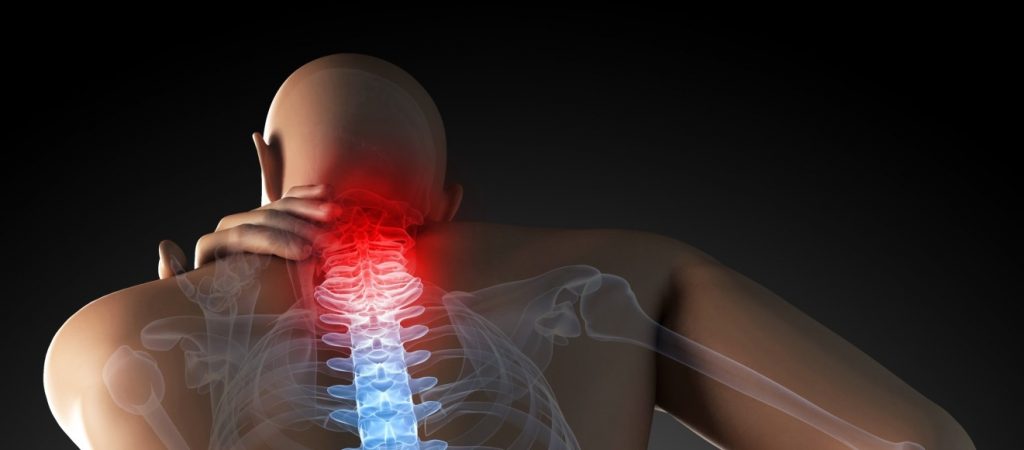 What is text-neck?
What is text-neck?
It’s neck pain associated with looking down at your cell phone or other wireless device for too long and too frequently. This posture of bending your neck to look down over the cell phone isn’t a new position. We have been hunching over for years with reading also. The main issue is that we look down for longer periods of time and more frequently in this day and age. What’s most concerning is that this posture is especially common in children! This could be setting them up for lifelong neck related damage and pain.
What are common symptoms of text-neck?
Neck pain, tightness, soreness, muscle spasms, and pain in the shoulders. If a cervical nerve becomes pinched, it can also lead to nerve pain that travels down your arm into your hand (neurological symptoms for cervical radiculopathy.) Text neck may also bring upon early onset of arthritis. So what can we do to help decrease these above painful neck conditions?
Take frequent breaks every 20-30mins.
Make sure you set up your computer so it’s at eye level at the desk so you’re not looking down excessively.
Try to hold your phone up higher to avoid looking down for too long.
Stretch your neck side to side, roll your shoulders back and down (opposite of being hunched over).
You should strengthen the core muscles of your neck and shoulder blade area (scapular stabilizers). These areas are crucial to build endurance in so that you don’t slump forward as much and predispose yourself to other injuries secondary to poor posture.
To learn how to offset the harmful effects of “text-neck”, book your chiropractic appointment now at dr.mdavidovic@gmail.com or 416-906-0767 with Dr. Maria Davidovic.
Kinesiotaping: why try it?
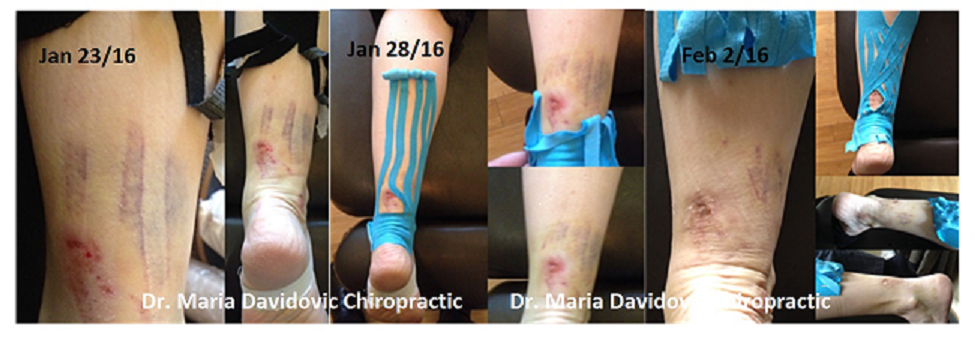
Kinesiotaping
In my practice, I’ve had some promising outcomes with the use of Kinesiotaping technique. (I use both kinesiotape and Spidertech tape – different brands of tape, both work well.) The most noticeable changes are when someone comes in with a swollen joint or with bruises. The tape material is hypoallergenic and latex free. The tape is applied to the affected area in a way where the skin is gently lifted. This allows room for inflammation to clear out in order for the bruising to fade faster. Or, you can PRICE (protection, rest, ice, compression, elevation) the affected area, but this will take longer to heal. Taping can also be used to help relax tight muscles by applying a special stretch technique. Or to even activate weak muscles. Taping can also be used for joint/postural support.
As a chiropractor, I love being able to have a variety of tools to utilize in helping patients recover faster in a safe and effective manner. There is even a special version of the tape that can be used for people with sensitive skin! For the most part, I’ve been using spider tech tape in my practice and the colour options are the following: beige, black, pink and blue. The variation in colour has no effect in the taping method used. They are just there for fun 🙂
Here’s a clinical example of how taping has helped speed up recovery:
A patient who was struck in the back of the leg as seen in the collage: after 11 days with the use of kinesiotaping technique to decrease inflammation, the bruising/inflammation is practically gone! Around this period, without tape, your bruise would be yellowish-brown. But, that all depends on the severity of the bruise and the persons overall health. I forgot to take a photo of the injured leg pre-tape job on the 23rd, but you can gather the area was quite bruised as seen in the pictures.
If you’d like to arrange an initial chiropractic visit or follow-up visit, and would like to try kinesiotaping, email dr.mdavidovic@gmail.com or call 416-906-0767 to arrange your follow-up
December Newsletter 2014 *Happy Holidays*
Here is the link to the pdf newsletter: DEC2014PrintLetter
It’s that time of year AGAIN! With the hustle & bustle of the holiday season, don’t forget to take good care of your immune system with adequate rest, a good diet, exercise and throw in your chiropractic “tune-up” visits, and your spine and nervous system will be good to go! While for some, this season can be a pain in the neck, figuratively speaking, many others suffer from acute or chronic headaches stemming from the neck. Read below on how chiropractic care can help you or someone you know.
Research Review
Efficacy of Spinal Manipulative Therapy (SMT) and Cervicogenic Headache (HA).
Cervicogenic headache is a secondary complaint from a disorder within the cervical spine or soft tissues of the neck. It is pain referred to the head from joint structures in the upper cervical spine. Patients with headache are frequently treated with spinal manipulative therapy, which is moving a “stuck” or restricted joint beyond someone’s physiological range in order to restore normal, pain-free motion.
According to research, SMT is effective in reducing HA intensity, duration and medication intake, and may also help to decrease headache frequency in Cervicogenic HA patients.
In my practice, I utilize MANY therapeutic techniques such as, the aforementioned, spinal manipulative therapy, cervical mobilization, which is challenging a restricted or “stuck” joint within someone’s physiological range of motion, Graston Technique®, Muscle Release Therapy, Kinesiotaping, therapeutic exercise, acupuncture and thoracic spine manipulation, which is also effective in decreasing neck pain (see next page.)
If you are experiencing neck pain and headaches and are unsure as to why that is, call or email to book a free 15 min consultation to find out how Chiropractic Care can help you.
Thoracic SMT for cervical spine pain and HA
Because of biomechanical, anatomical and nerve relationships between the cervical and thoracic spine, disturbances in the thoracic spine could contribute to the maintenance of neck pain. Treatment directed at the thoracic spine may have hypoalgesic (a decreased sensitivity to pain) or biomechanical effects on the cervical spine.
Preliminary evidence suggests that thoracic spine SMT may result in an immediate decrease in pain and an increase in cervical range of motion in patients with mechanical neck pain. (Flynn et al, 2001)
In a controlled study (Cleland et al.), they demonstrated that patients with mechanical neck pain who received thoracic spine manipulation experienced a significant immediate improvement in neck pain as compared to a sham manipulation group. The results showed a clinically significant reduction in pain at rest in subjects with mechanical neck pain immediately and 48 hours following a thoracic SMT.
You can follow me on Twitter & Facebook where I will be re-posting a headache diary and some easy neck exercises/stretches. Here’s wishing you a safe, healthy and happy holiday season with all the best to come in the New Year! J
One of the best gifts you can give this holiday season to a friend, colleague, family member, or significant other is sharing your experience with chiropractic care and your health accomplishments in 2014.
Invite a friend to come in for a free 15 min Consultation to learn more about Chiropractic Care
Cesar Fernandez-de-las-Penas et al. (2007). Changes in Neck pain and active ROM after a single thoracic spine manipulation in subjects presenting with mechanical neck pain: a case series. JMPT, 30:4.
Fernandez-de-las-Penas, C et al. (2005). Spinal Manipulative Therapy in the Management of Cervicogenic Headache. Headache, 45:1260-1270
PACK IT LIGHT. WEAR IT RIGHT.

Kids and backpacks just seem to go together. Whether you are heading out on holiday with the kids or sending them off to school, chances are they’ll be packing a backpack.
You have your own load too, whether it’s a fashionable new purse or a suitcase packed to bursting. Knowing how to choose, pack and lift backpacks, shoulder bags and luggage can prevent them from becoming a pain in the back.
Our common-sense guide will spare your back:
BACKPACKS
Choose carefully: Go for lightweight vinyl or canvas. Pick a pack that has two wide, adjustable and padded shoulder straps, along with a hip or waist strap, a padded back and plenty of pockets.
Pack it properly: Make sure the backpack contains only what is needed for the day or the activity. Distribute the weight of the contents evenly. The total weight of the filled pack should be no more than 10 to 15 per cent of the wearer’s body weight.
Wear it right: Both shoulder straps should always be used, and adjusted so that the pack fits snugly to the body without dangling to the side. Never sling a backpack over one shoulder. You should be able to slide a hand between the backpack and the carrier’s back.
It’s a fact! More than 50 per cent of young people experience at least one episode of low back pain by their teenage years. Research indicates one cause is improper use of backpacks. So pack it light and wear it right!
SHOULDER BAGS
Choosing a Shoulder Bag: Whether your bag is a purse or home to your laptop, choose one with a wide, padded adjustable shoulder strap.
Packing a Shoulder Bag: Divide the contents among multiple pockets to help distribute the weight and keep items from shifting. Your bag should not weigh more than 10 to 15 per cent of your body weight.
Carrying a Shoulder Bag: Don’t always carry your bag on the same shoulder, switch sides often so that each shoulder gets a rest. Try not to lift the shoulder on which the purse is carried, ideally wear the strap across your chest.
LUGGAGE
Choosing Luggage: Look for sturdy, light, high-quality and transportable pieces. Avoid purchasing luggage that is already too heavy when empty. Choose a bag with wheels and an adjustable handle when possible.
Packing Luggage: Over-packing is a pitfall. Ensure your luggage is never too heavy for you to pick up.
Lifting Luggage: Place carry-on luggage into the overhead compartment by first lifting it onto the top of the seat. Use your knees, not your back to lift!
The Last Word: Carrying a heavy load that is poorly distributed can cause a number of problems including muscle strain, headaches, neck, back and arm pain, and even nerve damage. It pays to pack it light and wear it right.
An informative article from the Ontario Chiropractic Association


